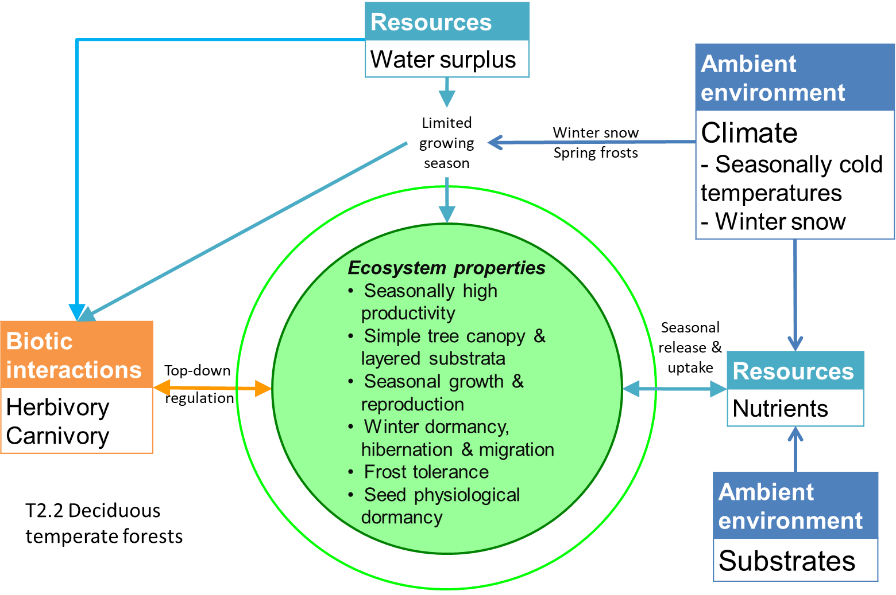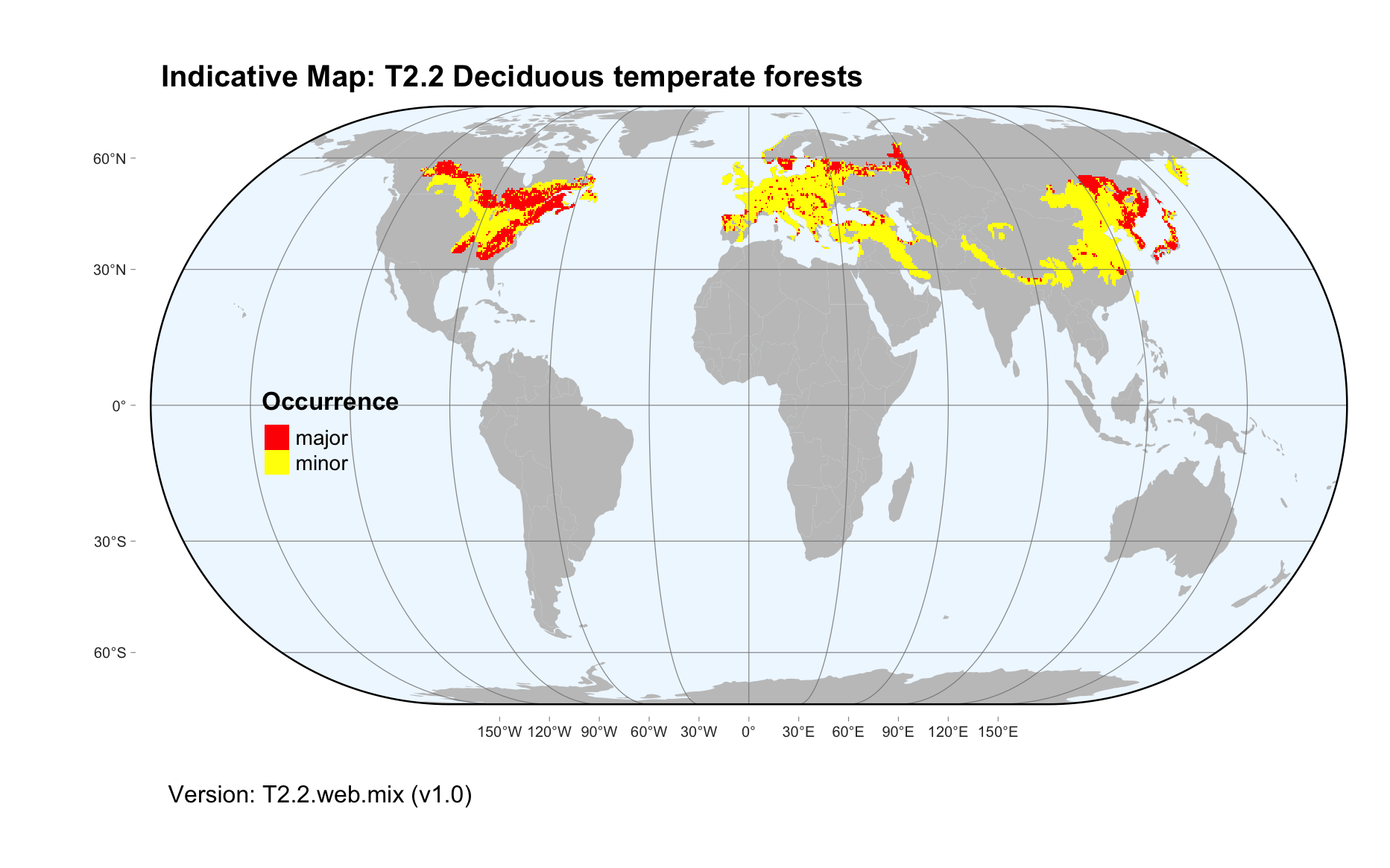Global ecosystem typology
Alternative site for the Global ecosystem typology with additional information for ecosystem profiles and indicative maps.
This site is maintained by jrfep
T2.2 Deciduous temperate forests
Biome: T2. Temperate-boreal forests and woodlands biome
Contributors:
(texts)
At cool temperate latitudes in the Northern hemisphere, fertile soils and high precipitation support forests dominated by broadleaf deciduous trees, although evergreen needleleaf trees may account for up to one-third of the canopy. Cold snow-prone winters punctuate a limited but highly productive growing season. Fungi and bacteria play vital roles in decomposition of the seasonal leaf fall on the forest floor, with insects and browsing herbivores important in carbon and nutrient cycling. Herbivores such as deer and hares are prey to feline, canine and avian predators. Winter dormancy, hibernation and migration are key strategies enabling survival of plants and animals.
Key Features
Closed canopy broadleaved forests in seasonally warm and cold humid climates, with low to moderate woody species diversity.
Overview of distribution
Temperate regions of the Northern Hemisphere, limited occurrences in southern South America.
Profile versions
- v1.0 (2020-01-20): DA Keith; NA Brummitt; F Essl; D Faber-Langendoen
- v2.0 (2020-05-31): DA Keith; NA Brummitt; F Essl; D Faber-Langendoen
- v2.01 ():
- v2.1 (2022-04-06): DA Keith; NA Brummitt; F Essl; D Faber-Langendoen Full profile available at official site
Main references
Selected references for this functional group:
Röhrig E, Ulrich B (1991) Temperate deciduous forests Ecosystems of the world Vol. 7. Elsevier, Amsterdam
Box EO, Fujiwara K (2015) Warm temperate deciduous forests Springer, Cham.
Diagrammatic assembly model

Maps
Maps are indicative of global distribution patterns are not intended to represent fine-scale patterns. The maps show areas of the world containing major (coloured red) or minor occurrences (coloured yellow) of each ecosystem functional group. See general notes on maps.
There are 2 alternative versions of the indicative map for this functional group, please compare description and sources below.
T2.2.IM.mix_v1.0
Datasets
- Resolve-Ecoregions-2017
- EarthEnv-LandCover-v1.0
Map references
Dinerstein E, Olson D, Joshi A, Vynne C, Burgess ND, Wikramanayake E, Hahn N, Palminteri S, Hedao P, Noss R, Hansen M, Locke H, Ellis EE, Jones B, Barber CV, Hayes R, Kormos C, Martin V, Crist E, Sechrest W, Price L, Baillie JEM, Weeden D, Suckling K, Davis C, Sizer N, Moore R, Thau D, Birch T, Potapov P, Turubanova S, Tyukavina A, de Souza N, Pintea L, Brito JC, Llewellyn Barnekow Lillesø JP, van Breugel P, Graudal L, Voge M, Al-Shammari KF, Saleem M (2017) An Ecoregion-Based Approach to Protecting Half the Terrestrial Realm, BioScience 67: 534–545. DOI:10.1093/biosci/bix014. Data-set available on-line
Tuanmu, M.-N. and W. Jetz (2014) A global 1-km consensus land-cover product for biodiversity and ecosystem modeling Global Ecology and Biogeography 23(9):1031–1045 DOI:10.1111/geb.12182
T2.2.web.mix_v1.0

Datasets
- Resolve-Ecoregions-2017
- EarthEnv-LandCover-v1.0
Map references
Dinerstein E, Olson D, Joshi A, Vynne C, Burgess ND, Wikramanayake E, Hahn N, Palminteri S, Hedao P, Noss R, Hansen M, Locke H, Ellis EE, Jones B, Barber CV, Hayes R, Kormos C, Martin V, Crist E, Sechrest W, Price L, Baillie JEM, Weeden D, Suckling K, Davis C, Sizer N, Moore R, Thau D, Birch T, Potapov P, Turubanova S, Tyukavina A, de Souza N, Pintea L, Brito JC, Llewellyn Barnekow Lillesø JP, van Breugel P, Graudal L, Voge M, Al-Shammari KF, Saleem M (2017) An Ecoregion-Based Approach to Protecting Half the Terrestrial Realm, BioScience 67: 534–545. DOI:10.1093/biosci/bix014. Data-set available on-line
Tuanmu, M.-N. and W. Jetz (2014) A global 1-km consensus land-cover product for biodiversity and ecosystem modeling Global Ecology and Biogeography 23(9):1031–1045 DOI:10.1111/geb.12182
Check: the Glossary / Profile structure / the public document